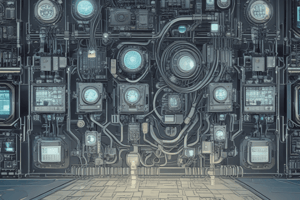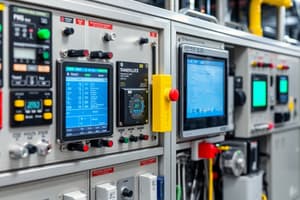Podcast
Questions and Answers
What is a critical element required to automate a process?
What is a critical element required to automate a process?
- Skilled human operators
- Physical machinery only
- Manual instructions
- Power to drive the process (correct)
Which of the following describes automation?
Which of the following describes automation?
- Completion of tasks requiring human oversight
- A method of increasing manual labor efficiency
- The use of machines to assist human workers
- Technology enabling processes without human assistance (correct)
What does mechanization refer to?
What does mechanization refer to?
- Replacement of human oversight in all tasks
- Complete independence from human labor in tasks
- Automation of processes without human input
- Use of powered machinery to assist human workers (correct)
Which function is part of advanced automation?
Which function is part of advanced automation?
What popular industry is most closely associated with the concept of automation?
What popular industry is most closely associated with the concept of automation?
What is NOT a basic element of an automated system?
What is NOT a basic element of an automated system?
Who coined the term automation and in what year?
Who coined the term automation and in what year?
What is one primary purpose of a control system in an automated setup?
What is one primary purpose of a control system in an automated setup?
What function does error recovery serve in an automated system?
What function does error recovery serve in an automated system?
Which statement best describes the role of sensors in the error detection process?
Which statement best describes the role of sensors in the error detection process?
What must be done to design an effective error detection subsystem?
What must be done to design an effective error detection subsystem?
What is the primary focus of error detection in automated systems?
What is the primary focus of error detection in automated systems?
In designing error recovery systems, what is essential to consider?
In designing error recovery systems, what is essential to consider?
How does a closed-loop control system differ from an open-loop control system?
How does a closed-loop control system differ from an open-loop control system?
What is a fundamental characteristic of automation in manufacturing?
What is a fundamental characteristic of automation in manufacturing?
What role does safety monitoring play in automated systems?
What role does safety monitoring play in automated systems?
What is an essential component that enables automated systems to perform their processes?
What is an essential component that enables automated systems to perform their processes?
Which type of automation allows for the production of multiple parts in a single work cycle, such as with plastic injection molding?
Which type of automation allows for the production of multiple parts in a single work cycle, such as with plastic injection molding?
What does the program of instructions in an automated system define?
What does the program of instructions in an automated system define?
In automated systems, what is the function of the control element?
In automated systems, what is the function of the control element?
What capability allows electric power to be utilized in various forms such as mechanical or thermal energy?
What capability allows electric power to be utilized in various forms such as mechanical or thermal energy?
How do work cycle programs ensure consistency in automated processes?
How do work cycle programs ensure consistency in automated processes?
In the simplest automated processes, what does the work cycle typically consist of?
In the simplest automated processes, what does the work cycle typically consist of?
What is the significance of storing electric energy in long-life batteries within automated systems?
What is the significance of storing electric energy in long-life batteries within automated systems?
What is one fundamental reason for implementing an automated system in manufacturing?
What is one fundamental reason for implementing an automated system in manufacturing?
Which of the following is NOT considered an advanced automation function?
Which of the following is NOT considered an advanced automation function?
What is the primary purpose of safety monitoring in an automated system?
What is the primary purpose of safety monitoring in an automated system?
Which mode is NOT typically part of maintenance and repair diagnostics?
Which mode is NOT typically part of maintenance and repair diagnostics?
In error detection and recovery, what type of events does this function primarily deal with?
In error detection and recovery, what type of events does this function primarily deal with?
What is the primary goal of failure diagnostics in an automated system?
What is the primary goal of failure diagnostics in an automated system?
Which aspect of automated systems is essential to ensure they do not become self-destructive?
Which aspect of automated systems is essential to ensure they do not become self-destructive?
What role does recommendation of repair procedures play in maintenance diagnostics?
What role does recommendation of repair procedures play in maintenance diagnostics?
Flashcards are hidden until you start studying
Study Notes
Introduction to Automation
- Automation refers to technology designed to perform processes without human intervention.
- Originated in 1946 at Ford Motor Company to describe automatic transfer devices in manufacturing.
- Modern automation heavily relies on computer technologies, unlike early implementations.
Learning Objectives
- Understand basic elements of an automated system.
- Explain advanced functions in automation.
- Identify various levels of automation.
Basic Elements of an Automated System
- Three core components:
- Power: Required to drive processes and operate systems.
- Program of Instructions: Directs the process and handles specific manufacturing steps.
- Control System: Executes the program to achieve defined functions.
Power to Accomplish Automated Processes
- Electric power is crucial in industrial settings and can be converted into different energy forms.
- Allows for functions such as signal transmission and data processing.
- Long-life batteries serve as a power source where direct electrical supply is unavailable.
Program of Instructions
- Defines required actions for each automated process, tailored for specific parts/products.
- Processing steps are executed during a work cycle; multiple steps can occur in environments like injection molding.
- Work cycle programs dictate the operational sequence, often referred to as part programs in numerical control.
Advanced Automation Functions
- Automation can perform complex functions beyond basic tasks to improve safety and efficiency:
- Safety Monitoring: Protects workers and equipment from hazards during automated operations.
- Maintenance and Repair Diagnostics: Assists in identifying system malfunctions, encompassing status monitoring and failure diagnostics.
- Error Detection and Recovery: Utilizes sensors to identify errors and enables automated systems to take corrective action without human input.
Levels of Automation
- Automation is applicable across different levels of factory operations, influencing both machinery and their subsystems.
- The complexity of automation increases as more subsystems become integrated into the overall control structure.
Review Questions
- Understanding definitions and differences in automated systems, including:
- Automation vs. Mechanization: Automation replaces human oversight entirely; mechanization assists but still requires human input for cognitive tasks.
- Recognizing the need for decision-making in programmed work cycles.
- Distinguishing between closed-loop (feedback systems) and open-loop (no feedback systems) control systems.
Studying That Suits You
Use AI to generate personalized quizzes and flashcards to suit your learning preferences.




